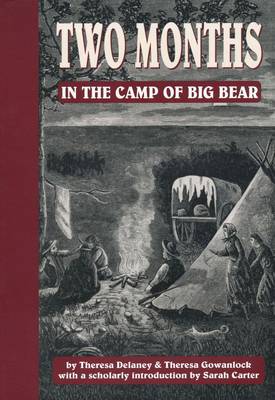
Door een staking bij bpost kan je online bestelling op dit moment iets langer onderweg zijn dan voorzien. Dringend iets nodig? Onze winkels ontvangen jou met open armen!
- Afhalen na 1 uur in een winkel met voorraad
- Gratis thuislevering in België vanaf € 30
- Ruim aanbod met 7 miljoen producten
Door een staking bij bpost kan je online bestelling op dit moment iets langer onderweg zijn dan voorzien. Dringend iets nodig? Onze winkels ontvangen jou met open armen!
- Afhalen na 1 uur in een winkel met voorraad
- Gratis thuislevering in België vanaf € 30
- Ruim aanbod met 7 miljoen producten
Zoeken
€ 22,45
+ 44 punten
Uitvoering
Omschrijving
In the spring of 1885, the names Theresa Delaney and Theresa Gowanlock captured the attention and imagination not only of Canadian, but also of American and overseas readers. After their husbands were killed by Plains Cree, the two women were among eighty hostages held for two months. During their captivity, horrendous rumours circulated as to the indignities they were suffering; Delaney and Gowanlock emerged from their ordeal safely, however, to declare that none of the rumours were true, that they had been treated well under the circumstances, and that they had been zealously protected by several Metis families. This was not the central message advanced in the published account, however, which was released five months later. In Two Months in the Camp of Big Bear, the accounts of the women were made to conform to the literary conventions of the Indian captivity narrative, capitalizing upon existing sets of images, symbols, and representations. A complicated story was simplified, heroes and villains were created, and this imaginative narrative became part of the formidable written and visual legacy of the events of 1885 that is narrow and one-sided.
Specificaties
Betrokkenen
- Auteur(s):
- Uitgeverij:
Inhoud
- Aantal bladzijden:
- 78
- Taal:
- Engels
- Reeks:
- Reeksnummer:
- nr. 3
Eigenschappen
- Productcode (EAN):
- 9780889771079
- Verschijningsdatum:
- 4/02/1999
- Uitvoering:
- Paperback
- Formaat:
- Trade paperback (VS)
- Afmetingen:
- 170 mm x 246 mm
- Gewicht:
- 226 g

Alleen bij Standaard Boekhandel
+ 44 punten op je klantenkaart van Standaard Boekhandel
Beoordelingen
We publiceren alleen reviews die voldoen aan de voorwaarden voor reviews. Bekijk onze voorwaarden voor reviews.











